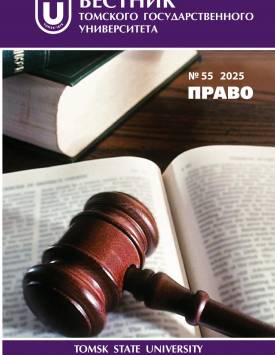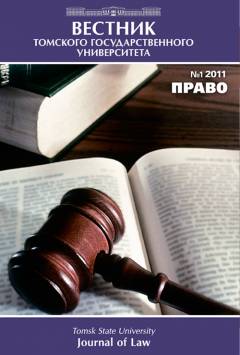Institutionalization of assisted human reproduction in Russian legislation: from problems to opportunities
The article examines the fundamental categories of the sphere of assisted human reproduction for the purposes of its institutionalization in Russian legislation. The law does not have adequate tools and does not have conceptual theoretical developments that meet the needs of regulating relations that develop under the influence of the dynamics of reproductive technologies. There have been no attempts in jurisprudence to systematize the existing factual phenomena belonging to the field of assisted reproduction. Existing scientific research is based on the search for foreign legal models in order to adapt them. The author has attempted a structural and systematic approach to the legal understanding of the actual relationship. The fundamental categories in the science of human reproduction are analyzed. The correlations of system-forming concepts in the context of their possible legislative consolidation are revealed. The legally significant properties and characteristics of biomedical concepts are determined. The provisions on the fundamental difference of identical terms in the contextual format «method», «technology» or «program» are formulated. A proposal has been made to reset the established social perception of artificial human reproduction. It is proposed to adopt the basic concept of assisted human reproduction in the meaning of any medical care to overcome infertility as the basis for subsequent legal transformations. The criteria for distinguishing manipulations and actions related to assisted reproductive technologies from other types of medical care to overcome infertility are fixed. Methodological conclusions are formulated about the importance of the moment of the emergence and termination of legal relations in the course of ongoing medical programs, including in vitro fertilization programs. The possible components of the surrogacy program are investigated, strategic directions of legal regulation are determined. The features of the gamete donation program are considered. It is concluded that gamete donation has an absolute specificity due to the biological characteristics of the donor material and the procedure for obtaining it, which requires additional research. It is argued that gamete donation should not be artificially separated from the donation institute, which is historically earlier and has independent tasks and principles. The conceptual characteristics of the cryopreservation program and the directions of further research in this area are outlined. It is proposed to consolidate the norms on medical care in the field of assisted reproduction in the Federal Law «On Assisted Human Reproduction». Contradictions on the issue of synchronizing regulatory regulation with family legislation have been resolved. A general conclusion is drawn about the need to create new legal structures for the integration of technological development phenomena into the legal system. The author declares no conflicts of interests.
Keywords
medically assisted reproduction,
assisted reproductive technology,
in vitro fertilization,
legal regulationAuthors
| Krasnova Tatiana V. | Tyumen State University | krasnova-tv@yandex.ru |
Всего: 1
References
Большая российская энциклопедия. URL: https://old.bigenc.ru/medicine/text/2140473 (дата обращения: 19.09.2024).
Приказ Министерства здравоохранения СССР от 13 мая 1987 г. № 669 «О расши рении опыта по применению метода искусственной инсеминации спермой донора по медицинским показаниям». URL: https://base.garant.ru/4176154/?ysclid=m1hly2lq39696913097 (дата обращения: 19.09.2024).
Основы о браке и семье. 1990. Закон 1501-1. Ст. 17. URL: https://base.garant.ru/1566140/?ysclid=m1hlzubfyn303911355 (дата обращения: 19.09.2024).
Основы законодательства Российской Федерации об охране здоровья граждан от 22.07.1993 № 5487-1. утв. ВС РФ 22.07.1993 № 5487-1.
Приказ Минздрава РФ от 28.12.1993 № 301 «О применении метода искусственной инсеминации женщин спермой донора по медицинским показаниям и метода экстракорпорального оплодотворения и переноса эмбриона в полость матки для лечения женского бесплодия» // Минюст РФ. 10.01.1994. № 453.
Семейный кодекс Российской Федерации от 29.12.1995 № 223-ФЗ // Собрание законодательства Российской Федерации. 01.01.1996. № 1. Ст. 16.
Федеральный закон №» 323-ФЗ от 21.11.2011 «Об основах охрана: здоровья граждан в Российской Федерации» // Собрание законодательства Российской Федерации. 2011. № 48. Ст. 6724; 2019. № 52. Ст. 7770.
Аншина М.Б., Долгушина Н.В., Колода Ю.А., Корсак В.С., Савина В.М., Смирнова А.А. Терминология вспомогательных репродуктивных технологий: Международный глоссарий // Проблемы репродукции. 2019. № 25 (1). С. 6-15. doi: 10.17116/repro2019250116 (дата обращения: 19.09.2024).
Комиссарова Е.Г. Действующая нормативная модель происхождения ребенка в контексте биомедицинских достижений // Lex Russica. 2024. doi: 10.17803/1729-5920.2024.207.2.022-037 (дата обращения: 19.09.2024).
Письмо Минздрава России от 05.03.2019 № 15-4/И/2-1908 «О направлении клинических рекомендаций (протокола лечения) «Вспомогательные репродуктивные технологии и искусственная инсеминация»» (вместе с «Клиническими рекомендациями (протоколом лечения)», утв. Российским обществом акушеров-гинекологов 28.12.2018, Российской ассоциацией репродукции человека 21.12.2018) // СПС «КонсультантПлюс» (дата обращения: 15.09.2024).
Богданова Е.Е., Белова Д. А. Искусственная репродукция человека: поиск оптимальной модели правового регулирования. М. : Проспект, 2021. 216 с.
Сыманюк Э.Э., Полякова И.Г., Меньшиков А.С. Трансформация семейных связей под влиянием вспомогательных репродуктивных технологий // Quaestio Rossica. 2022. Т. 10, № 2. С. 657-676. doi: 10.15826/qr.2022.2.694.
Довнар А. Н. Стратегии деторождения в контексте применения ВРТ: новые подходы к решению старых проблем в правовом регулировании // Медицинское право. 2024. № 2. С. 32-35.
Петрова Е.В., Михалевич С.И. Основные этапы преодоления бесплодия с использованием программы вспомогательных репродуктивных технологий и ее модификаций // Медицинские новости. 2012. № 2. URL: https://cyberleninka.ru/article/n/osnovnye-etapy-preodoleniya-besplodiya-s-ispolzovaniem-programmy-vspomogatelnyh-reproduktivnyh-teh-nologiy-i-ee-modifikatsiy (дата обращения: 10.09.2024).
Шарловский К. А. «Выздоравливать отсюда»: конституционно-правовое определение категории «медицинская помощь» // Сравнительное конституционное обозрение. 2024. № 1. С. 4-24.
CRISPR and the Future of Fertility Innovation, 23 SMU Sci. & Tech. L. Rev. 31. URL: https://advance.lexis.com/api/document?collection=analytical-materials&id=urn:contentItem: 61FC-R8P1-JWXF-248S-00000-00&context=1516831 (дата обращения: 19.09.2024).
Yan Zhang, Xiaomei Zhou, Ye Zhu, Hanbin Wang, Juan Xu, Yiping Su. Current mechanisms of primordial follicle activation and new strategies for fertility preservation // Molecular Human Reproduction. 2021. № 27. doi: 10.1093/MOLEHR/GAAB005.
Мохов А.А. Стратегически значимые медицинские технологии: правовой аспект // Государство и право. 2020. № 11. С. 106-114.
Закон № 102-493 «Об успешности клиники фертильности и сертификации» от 24.10.1992. URL: https://www.congress.gov/bill/102nd-congress/house-bill/4773/text (дата обращения: 19.09.2024).
What is Assisted Reproductive Technology? URL: https://www.cdc.gov/art/whatis.html (дата обращения: 19.09.2024).
Лаврентьева Т.В. Особенности правового регулирования вспомогательных методов репродукции человека // Диалог. 2018. № 3 (12). URL: https://cyberleninka.ru/article/n/osobennosti-pravovogo-regulirovaniya-vspomogatelnyh-metodov-reproduktsii-cheloveka (дата обращения: 09.09.2024.
Приказ Минздрава России от 31.07.2020 № 803н «О порядке использования вспомогательных репродуктивных технологий, противопоказаниях и ограничениях к их применению» (зарегистрировано в Минюсте России 19.10.2020 № 60457). Ст. 8 // СПС КонсультантПлюс (дата обращения: 15.09.2024).
Кириченко К. А. О двух подходах к пониманию правовой сущности вспомогательных репродуктивных технологий // Медицинское право. 2011. № 3. С. 35-41.
Хамитова Г.М., Сафиуллина З.А. Правовая проблема суррогатного материнства для одиноких отцов и пути ее решения // Закон и право. 2024. № 3. URL: https://cyberleninka.ru/article/n/pravovaya-problema-surrogatnogo-materinstva-dlya-odinokih-ottsov-i-puti-ee-resheniya (дата обращения: 24.09.2024).
Постановление Пленума Верховного Суда РФ от 16.05.2017 № 16 (ред. от 26.12.2017) «О применении судами законодательства при рассмотрении дел, связанных с установлением происхождения детей» // Бюллетень Верховного Суда РФ. 2017. № 7.
Трубицын М.А., Шумкина Л.И. Проблемы нормативно-правового регулирования в сфере суррогатного материнства // Медицинское право. 2023. № 1. С. 24-29.
Определение Конституционного Суда РФ от 27.09.2018 № 2318-О «Об отказе в принятии к рассмотрению жалобы граждан С.Д. и С.Т. на нарушение их конституционных прав пунктом 4 статьи 51, пунктом 3 статьи 52 Семейного кодекса Российской Федерации, пунктом 5 статьи 16 Федерального закона “Об актах гражданского состояния”, частью 9 статьи 55 Федерального закона “Об основах охрана: здоровья граждан в Российской Федерации”» // СПС «КонсультантПлюс» (документ опубликован не был).
Prentice D.A. 3-parent embryos, gene edited babies and the human future // Issues Law Med. 2017. № 32 (2). Р. 233-240. PMID: 29108146. URL: https://advance.lexis.com/api/document?collection=analytical-materials&id=urn:contentItem:5PKM-D8J0-00CW-60RW-00000-00&context=1516831/(дата обращения: 19.09.2024).
Митрякова Е.С. Потенциальные родители в договоре суррогатного материнства: сужение круга лиц // Семейное и жилищное право. 2023. № 2. С. 14-17.
Бурмистрова Е. В. Правовая природа договора суррогатного материнства // Современное право. 2023. № 10. С. 74-78.
Pantos K., Maziotis E., Trypidi A., Grigoriadis S., Agapitou K., Pantou A., Nikolettos K., Kokkini G., Sfakianoudis K., Pomeroy K.O. et al. The Effect of Open and Closed Oocyte Vitrification Systems on Embryo Development: A Systematic Review and Network Meta-Analysis // Journal of Clinical Medicine. 2024. № 13 (9). Р. 2651. doi: 10.3390/jcm13092651.
Якушев В.С. О понятии правового института // Избранные труды по гражданскому и хозяйственному праву. Екатеринбург : Бизнес, менеджмент. Право, 2007. 440 с.
Алексеев С.С. Собрание сочинений: курс лекций : в 10 т. Т. 3: Проблемы теории права. М. : Статут, 2010. 781 с.
Алейникова В. В. Актуальные вопросы правоприменительной практики в сфере вспомогательных репродуктивных технологий // Закон. 2022. № 6. С. 126-138. doi: 10.37239/0869-4400-2022-19-6-126-138 (дата обращения: 19.09.2024).
Special issue assisted reproduction technology surrogacy, identity, parentage and children's right. URL: https://advance.lexis.com/api/document?collection=analytical-materials&id=urn:contentItem:61YV-K0W1-FH4C-X0CH-00000-00&context= 1516831 (дата обращения: 19.09.2024).
Tracey Tomlinson, A CRISPR Future for Gene-Editing Regulation: A Proposal for an Updated Biotechnology Regulatory System in an Era of Human Genomic Editing, 87 Fordham L. Rev. 437 (2018). URL: https://ir.lawnet.fordham.edu/cgi/viewcontent.cgi?article=5548&context=flr (дата обращения: 19.09.2024).
Tara R. Melillo, Gene Editing and the Rise of Designer Babies, 50 // Vanderbilt Law Review. 2021. № 757. URL: https://scholarship.law.vanderbilt.edu/cgi/viewcontent.cgi?article=1139&context=vjtl (дата обращения: 19.09.2024).
Cwik B. Moving Beyond 'Therapy' and 'Enhancement' in the Ethics of Gene Editing // Camb Q Healthc Ethics. 2019. № 28 (4). Р. 695-707. doi: 10.1017/S0963180119000641. PMID: 3152642.
Синюков В.Н. Право XX и XXI веков: преемственность и новизна // Lex Russica. 2021. № 2 (171). URL: https://cyberleninka.ru/article/n/pravo-xx-i-xxi-vekov-preemstvennost-i-novizna (дата обращения: 19.09.2024).

